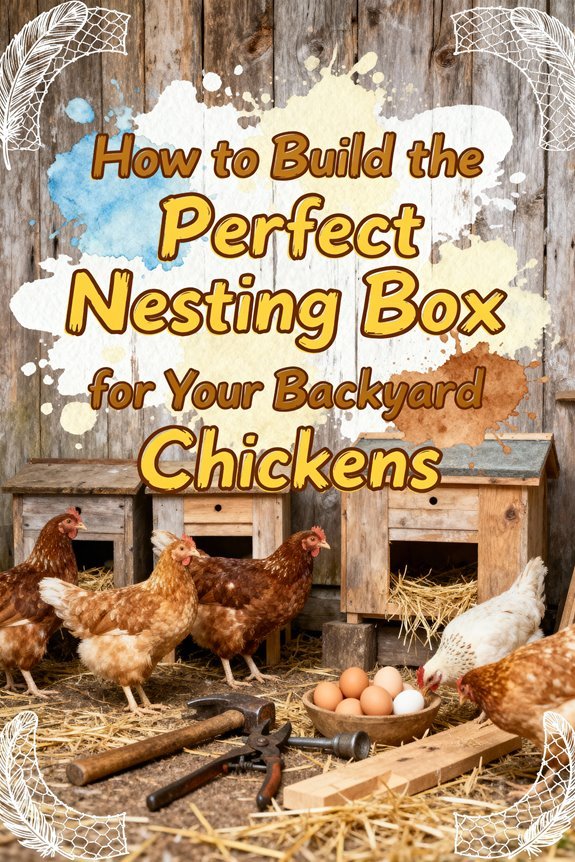How to Build the Perfect Nesting Box for Your Backyard Chickens
Build your perfect chicken nesting box using standard dimensions of 12x12x14 inches, positioning it 18 inches off the ground. You’ll need basic tools like a saw, drill, and fasteners, plus weather-resistant wood or plastic materials. Install a 4-6 inch front lip to keep eggs secure, and add pine shavings for bedding. Plan one box for every 4-5 hens, and include a sloped roof to prevent roosting. The right design choices will transform your backyard egg production.
Essential Size Requirements for Nesting Boxes
Three key dimensions determine the success of your chicken nesting boxes: width, depth, and height. For standard breeds, you’ll want to build boxes that are 12 inches wide, 12 inches deep, and 14 inches tall. If you’re raising bantams, you can reduce these box dimensions to 10x10x12 inches, while heavy breeds need slightly larger spaces of 14x12x14 inches. Installing aspen excelsior pads provides a natural, comfortable base for your laying hens.
When planning for egg accessibility, include a 4-6 inch front lip to keep eggs and nesting material secure. Position your boxes 12-24 inches off the ground to prevent predators from reaching them while ensuring your hens can easily hop in. For optimal egg laying conditions, consider adding privacy curtains to create a dark, safe environment. If you’re unsure of your chickens’ breed size, stick to the standard 12x12x12-inch minimum – it’s a reliable size that works for most hens. Plan to install multiple boxes to accommodate one box for every 4-5 hens in your flock.
Selecting the Right Materials and Tools
With your nesting box dimensions planned, gathering the right materials and tools is your next step to success. Start with a material comparison between wood, plastic, or metal boxes – wood offers natural insulation but requires sealing, while plastic and metal provide easier cleaning. You’ll need a measuring tape, pencil, saw, drill, and appropriate fasteners for assembly, plus protective gear like gloves and a dust mask. A secure locking system is essential to protect your chickens from nighttime predators. Plan to position boxes at standard height dimensions of 18 inches from the floor for optimal access.
For nesting material, pine shavings offer the best cost-to-benefit ratio, providing softness and absorbency while remaining biodegradable. While commercial nest pads cost more upfront, they’ll save you money long-term through reduced maintenance. If you’re budget-conscious, consider repurposing clean containers or crates, but make certain they’re properly sealed and fitted with comfortable, absorbent bedding to protect your hens’ eggs. For optimal egg protection and cleanliness, consider using aspen shaving liners that feature a kraft paper backing to prevent scratching hens from displacing the bedding material.
Step-by-Step Construction Guide
Building your chicken nesting box starts with constructing a solid frame using 2×4 lumber. Drill pocket holes at 1 1/2″ depth and join the pieces with 2 1/2″ screws for clean, sturdy connections. Next, cut your plywood panels to size – approximately 13″ by 48″ for the floor, back, and roof sections. Create interior compartment designs by installing middle dividers with 1/2″ pocket holes and 1″ screws. Add a 4-6″ front lip to keep eggs secure and attach a landing perch for easy hen access. For ideal nesting box aesthetics and functionality, construct a 45-degree sloped roof to prevent roosting. Individual compartments provide each hen with her own private nesting area. Finally, install curtains across the openings to create private, dark nesting spaces your hens will love. Your exterior access design will make collecting eggs convenient without disturbing the chickens inside the coop. The nesting boxes should accommodate six laying hens comfortably within your 24-square-foot coop space.
Creating the Perfect Location and Setup
Selecting the ideal location for your nesting boxes can make or break your chickens’ egg-laying success. Position boxes about 18 inches off the ground in a quiet environment, away from high-traffic areas and coop entrances. You’ll want to make sure they’re lower than the roosts but not directly underneath them to prevent droppings from soiling the nests.
For best nesting box placement, choose a slightly dim, secluded spot that’s still easily accessible for daily egg collection. Install boxes so you can gather eggs from the back or side without entering the coop or disturbing your hens. Group the boxes together in a convenient section, avoiding hard-to-reach corners. Remember to protect the area from drafts and predators, especially if your coop has open sides or is mobile. Adding back-opening doors will make collecting eggs more convenient while minimizing stress on your hens.
Comfort Features Your Hens Need
Comfort stands as an essential factor in creating successful nesting boxes that encourage consistent egg laying. You’ll need to focus on your hens’ preferences by providing soft, cushioning materials that prevent egg breakage and make laying comfortable. Line your boxes with AstroTurf pads, pine shavings, or dried grass clippings, guaranteeing a thick layer of padding. For optimal results, use the recommended 48-inch length size to accommodate multiple hens comfortably.
Don’t forget to install a raised sill or lip at the box’s entrance to keep nesting materials and eggs secure inside. Create a dim, private environment by adding curtains or visual barriers that block direct sunlight while still allowing enough light for your hens to see. Consider adding dried mealworms as a treat incentive to encourage nesting box use. Remember to maintain similar conditions across all boxes, as this prevents competition and guarantees your hens will use each nesting space equally.
Maintenance and Cleaning Tips
A well-maintained nesting box guarantees your chickens stay healthy and productive year-round. Remove soiled bedding weekly and scrape out droppings to prevent bacterial growth. During bedding management, add fresh wood shavings or straw after collecting eggs, and promptly replace any wet or caked material. For successful chicken keeping, maintain one box per 4-6 hens in your coop.
For effective disease prevention, deep clean your nesting boxes monthly using hot, soapy water, followed by a natural disinfectant like vinegar. Let boxes dry completely before adding new bedding. Collect eggs daily to maintain cleanliness and prevent breakage. When performing seasonal deep cleans, remove the entire nesting box from the coop for thorough sanitization. Don’t forget to wear protective gear like gloves and masks while cleaning to protect yourself from dust and pathogens. Consider sprinkling diatomaceous earth in nesting boxes to naturally prevent lice and mites. Regularly inspect the area around nesting boxes for signs of fire ant colonies to prevent potentially dangerous infestations that could harm your flock.
Troubleshooting Common Nesting Box Issues
When your chickens experience nesting box problems, you’ll need to identify and address issues quickly to maintain egg production. Start by checking for egg breakage, which often leads to egg-eating behavior. Install rollout nesting box designs to prevent hens from accessing freshly laid eggs. Consider using standard box dimensions of 12x12x12 inches for optimal comfort.
Ensure proper box placement to discourage chickens from sleeping inside and soiling the area. Add sufficient nesting material like straw or hay to cushion eggs and keep them clean. Installing a solar-powered roost mechanism can automatically prevent hens from roosting in nesting boxes overnight. Consider using plastic nest boxes that resist moisture and are easy to sanitize with water. If your hens aren’t using the boxes, try placing fake eggs or golf balls to encourage proper laying habits.
Monitor for signs of stress or overcrowding, as these can affect laying patterns. Calculate one nesting box for every 4-5 hens, and position boxes at a comfortable height. Regular inspections and prompt maintenance will help prevent most common nesting box issues.




